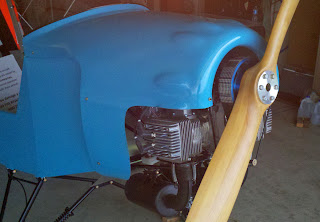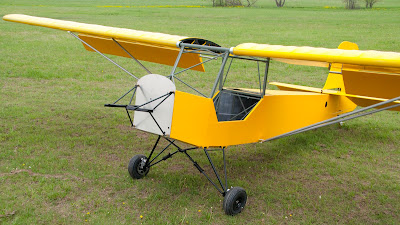This is my third post today! I've already posted on CG calculations in a tricycle gear ultralight aircraft (such as our Belite), also on a Chinese ultralight aircraft which was built for less than $400. Please rummage around my block and look at all the posts.
I made some changes to the aluminum fuselage tricycle gear design, then immediately proof tested them. I think the results are very impressive. You can see for yourself in the pictures. I always enjoy seeing pictures of lightweight structures which hold many times their own weight.
Here are the three tests I made:
1. Elevator @ 62 mph @ maximum deflection @ 150% of load calculation. Calculation was made with flat plate area of elevator at coefficient of lift of 1 of the elevator. According to airfoil theory, this represents maximum force when a flat plate is used as lifting surface. (This includes many aircraft of many designs, including our 'prewelded steel elevator' option on our Belite ultralight aircraft.)
2. Rudder @ 62 mph @ maximum deflection @ 150% of load calculation.
3. Twisting effect of rudder on fuselage, @ 62 mph @ maximum deflection @ 150% of load calculation.
Let's look at the pictures. First of all, the elevator deflection test:
 |
| Elevator force proof test in ultralight aircraft from Belite |
Then we tested the rudder force. This was done by placing the fuselage on the side, and adding weight. Since the rudder is much smaller than the horizontal stabilizer, the weight is lower. I calcuated a max force of 48 pounds, so I tested at 75 pounds. Basically the same setup as the prior test, except the fuselage is on the side. Here's the proof test:
 |
| Proof test of total rudder force on a Belite ultralight aircraft fuselage |
 |
| Proof test of rudder twisting on Belite ultralight aircraft with aluminum fuselage |
The steel bar is bending a lot. In the actual aircraft, the rudder force is supported by the flying wires which connect the rudder to the elevator (and also the fuselage, of course...)
The purpose of all of this was to show that the strength of the fuselage is adequate, even without fabric covering. Also, to show an alternate way to create the fuselage out of aluminum for a tricycle gear configuration.
My comments:
1. The structure clearly had a lot of reserve. If I wanted to increase strength, it was obvious where to add a couple of aluminum members to avoid Euler's buckling. (Need to know more? Go Google Euler, pronounced 'Oiler'.)
2. I encourage customers and ultralight enthusiasts to understand these kinds of tests. Maybe even do them on their own airplanes.
3. The calculations were for flat plate areas of the elevator / rudder, not the horizontal stabilizer / vertical stabilizer.
4. Any control surface movements which the pilot initiates from the top of the green airspeed (in the yellow to the red, Vne, from 63MPH to 80MPH) must be proportionally limited by the pilot. In other words, make slight and smooth control surface movements when you are operating in the yellow arc, just like a real airplane. Because a Belite ultralight aircraft is a real airplane....
Here's some bonus pictures of the tests:
 |
| Looking down the fuselage of an ultralight airplane, with load applied. There appears to be a huge reserve in the fuselage strength. |
 |
| That's me! :-) I am also building a flaperon at the same time. And looking distracted. |
 |
| The joy of torque. |
 |
| The joy of strength in a structure. |
The entire weight of the aluminum fuselage (including the cabin) in this Belite weighs about 40 pounds.













































